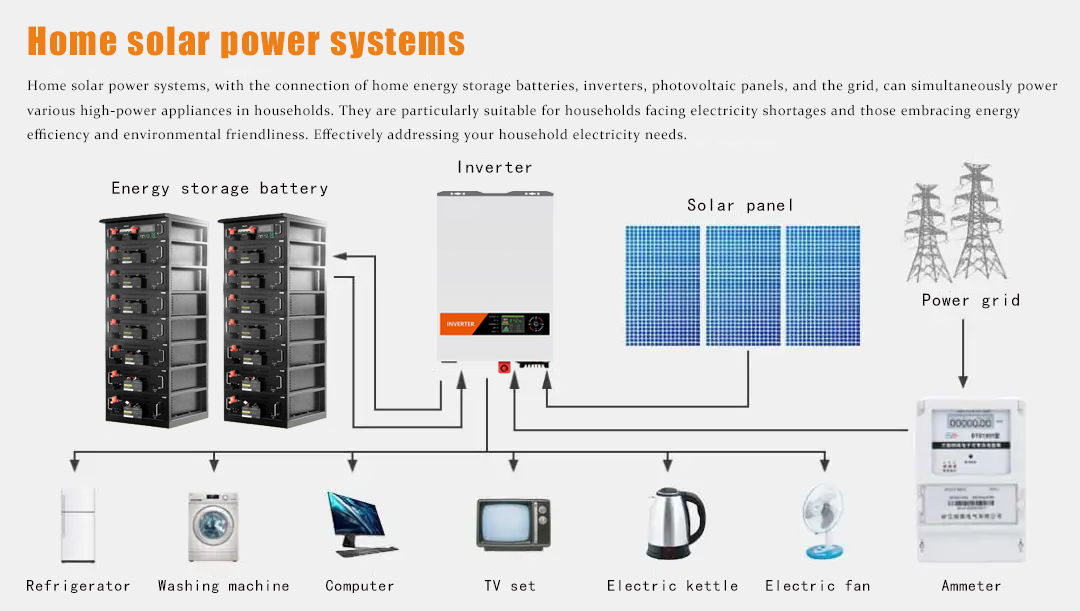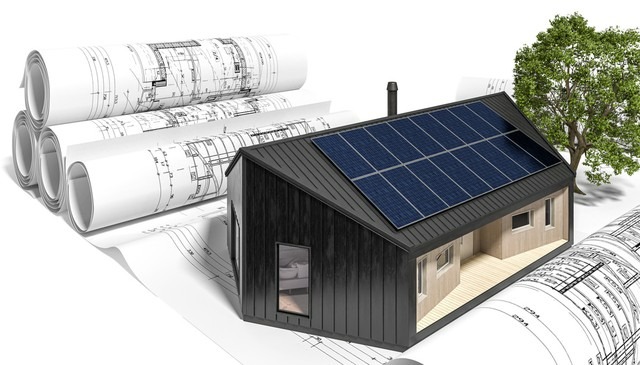How to configure the home energy storage battery and its system
Since 2022, the demand for home energy storage batteries has been steadily increasing worldwide. As a new market, both the products and the market are still in the exploratory stage. Considering the high cost of home energy storage batteries, it is crucial to use the home storage system efficiently and economically. In this article, the author from Shenzhen Pengcheng New Energy draws on years of experience to analyze and summarize the configuration design and requirements of home energy storage battery systems.
1.Solar home energy storage battery system structure

The picture above is a typical household energy storage battery system, which is mainly composed of solar panels, power grid, inverter, battery, and electrical equipment. Among them, those with only solar panels at the input end are called off-grid systems, while those with solar panels and city grid input at the same time , called a mixed network system. If there is only mains input, it is usually a backup power system.
2. User needs analysis
First, we must understand the type of electrical equipment used by the user and the power of the equipment. First, make a list of the user’s electrical equipment, fill in the maximum power, and then calculate the total power P0. P0=P1+P2+P3+….+Pn;Understand the number of electrical equipment that may be used simultaneously, and calculate the total power value P1. The purpose of this step is to prepare for a more reasonable configuration of the inverter in the future.
3.Inverter Selection
3.1 Power Selection
Choose an inverter with a rated power higher than the P0 value based on user demand analysis.If the customer’s budget is limited, consider lowering the requirements and selecting an inverter with a rated power > P1.The inverter’s maximum output power determines the maximum power capacity for simultaneous appliance usage.Proper sizing is crucial to avoid overloading and potential damage to the inverter.
3.2 Type Selection
Inverters can be high-frequency or power frequency.
Industrial frequency inverters are more reliable, utilizing mature thyristor (SCR) rectifier technology.
High-frequency inverters, using IGBT high-frequency rectifiers, offer better environmental adaptability with reduced size, weight, and noise.Industrial frequency inverters are preferable for load requirements regarding zero-ground voltage.
3.3 Voltage Selection
Inverters come in low-voltage and high-voltage systems.
Low-voltage systems refer to input voltages below 48V, while high-voltage systems are 96V and above.
High-power output inverters, typically above 10KW, are often high-voltage systems.
For high-power requirements with a low-voltage system, parallel configuration is necessary.
3.4 Brand Selection
Consider well-known brands with a good reputation in the industry.
Ensure compatibility with household energy storage batteries.
Energy Configuration of Household Energy Storage Batteries
4. Battery System
4.1 Battery options include lead-acid, ternary lithium, and lithium iron phosphate batteries.
Lead-acid batteries are standard, affordable, and adaptable but have a shorter lifespan and environmental concerns.
Ternary lithium batteries offer high energy density but have lower safety and shorter lifespan compared to lithium iron phosphate batteries.Lithium iron phosphate batteries provide safety and longer lifespan but are larger and heavier than ternary lithium batteries.
Lead-acid batteries are widely used, while ternary lithium and lithium iron phosphate batteries find applications in specific scenarios.
4.2 Home Energy Storage Battery Voltage Matching
The voltage of the battery should match the inverter’s input voltage.
4.3 Energy Configuration of Household Energy Storage Batteries
Determine the energy configuration based on the user’s budget and desired duration of full-power usage.Energy (Q) of the battery is calculated as Q = P * h / β, where P is the total power of user equipment, h is the desired usage time, and β is the inverter’s conversion efficiency.
4.4 Output Power
Output power depends on the system design, battery discharge rate, system structure’s maximum current capacity, BMS current, and heat dissipation performance.For example, a 48V system with a maximum designed output current of 100A can deliver an output power of 4800W.
4.5 Functional Requirements
Additional functions like display, mobile app monitoring, and remote control can be included based on user needs.
5.Photovoltaic Module Configuration
5.1 Maximum Allowable Installed Power
The available installation area, typically the roof, determines the maximum total power of solar panels that can be installed.
If the available area is S square and each solar panel has an area of S1 and power of Pw, the maximum allowable installed power is P = S / S1 * Pw.
5.2 Actual Solar Panel Power
Determined by the user’s requirements and system design.Consider the battery charging time (T) and effective lighting time (t) to calculate the required solar panel power.P = battery energy / T / t = Q / T / t, where P should be less than or equal to the maximum allowable installed power.
6.Other Accessories
6.1 Installation Bracket
Refers to the bracket used for solar panel installation.
Choose based on the number of solar panels and the installation method.
6.2 Wire
Various connection cables are determined during system design.

